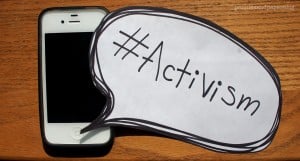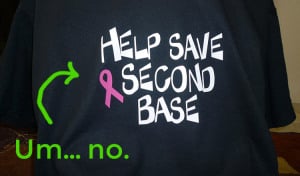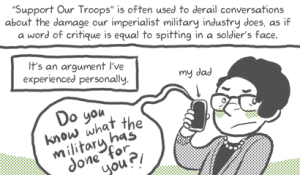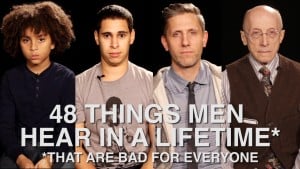Let me tell you a secret: I’ve found the world’s best caesar salad. It’s two big romaine hearts grilled (on an actual grill, no less!), with fresh shaved parmesan cheese and delectably crunchy croutons. And! And! You get to eat it with a steak knife! It’s the fiercest salad and I love it.
But I gotta tell you another secret: sometimes it leaves a sour taste in my mouth.
This is because despite all the deep care that goes into this dish, it almost always comes with a side of misgendering. I’ll explain.
When Dining Out Becomes a Drag
If my budget were a wee bit bigger, I would eat at the restaurant down the street (let’s call it Caesar’s Palace) every day.
Also, if I wasn’t agender.
And if my partner wasn’t non-binary.
This is because from the moment we walk into Caesar’s Palace to the moment we exit, we’re soaked in gendering.
“Hello ladies!”
“Can I get you girls anything?”
“The women’s restroom is that way.”
One time, we counted the word “ladies” used thirteen times in an interaction at the table.
Ow. Ow. Ow. Ow. Ow. Ow. Ow. Ow. Ow. Ow. Ow. Ow. Ow.
In restaurants, gendering inevitably crops up in various ways, from the microaggressive to the violent.
Not to mention, being misgendered can hurt on its own.
But what if an employee calls you a lady, and your ID doesn’t “match” what the server sees? What if the employee questions you about your ID? Do you tell them your gender? Can you still enter? Do you still want to?
Or what if an employee calls you a lady, and the bathrooms are gender segregated? Where do you go to the bathroom?
Does this mean you have been “assigned” to the ladies’ room? What happens if you “defy” your assignment? And what happens if the women in the ladies’ room are upset you’re there?
Or what if an employee calls you “ladies,” and the diners next to you look over and become curious, upset, or angry that you’re sitting next to them. You don’t look like ladies should! What if they murmur slurs? What if they stare? What if they follow you out?
How do you eat your dinner then?
The Many Faces of Misgendering
When my partner and I are gendered, it’s as if the air deflates a bit.
Achy feelings swell and animation fades. Conversation becomes hushed, and our sense of being present is challenged.
But while we share ouches, there’s a difference between our experiences of misgendering that’s driven by our very different presentations.
On my end, my preferred drag is what most folks would call femme. If I can slap an accent belt on a high-waisted dress, I’m in. The bigger the hair, the better. Cat eyes on Tuesday afternoons. I’m here for it all.
On the inside, though, I’m a gender void. A Bermuda Triangle where gender hasn’t been seen in 32 years.
The best analogy I can draw is to atheism – an atheist can acknowledge religion is very real and that folks have deep and personal connections to faith that may or may not align with religious structures, and yet the atheist has no personal connection to a god.
This is my internal (lack of) experience of gender.
For a short period of time, I tried to present androgynously in the interest of being visible as an agender person. Unfortunately, for assigned female folks, androgynous is often synonymous with masculine. And it just wasn’t for me – I didn’t feel like me at all. And I didn’t feel fly.
So I settled into the drag that feels the most rewarding to me, understanding that releasing my short hair and ties meant releasing my visibility.
I get that most folks don’t have the gender tools to read me as agender. On one hand, this provides me immense safety in public. To be sure, I receive the misogyny lobbed out of cars and entitled hands at femme people everywhere.
But let me be clear: This isn’t coupled by trans-antagonism or transmisogyny because I’m not read as trans or gender nonconforming.
On the other hand, invisibility is a creeping ache. While I’m working to convince my queer communities I’m agender, I’m spending years doing the same with my (shout out: very open to learning) family.
It’s a trend, it’s not real, it’s a plea for attention, I’ll try to use your pronouns but it’s hard because you look like that. These are phrases that continuously come at me from many directions.
So when I’m gendered by a stranger, I get it. If my community struggles with it, and my family struggles with it, it’s fair to imagine strangers will, too.
And, at the same time, it saps the energy from my muscles, it renders my voice quiet, it makes my fists tremble, and it just plain hurts.
But when misgendering is fired at me, it’s often through cisgenderism or general ignorance. For my partner, it’s a bit different.
My partner is an androgynous creature. Their appearance is a beautiful swirling, and storming, and smashing elimination of everything folks think gender is.
The sort that gets the queer nod of recognition on the street.
The sort that sends strangers swirling into “Hi, sir. Oh, jeez, I’m sorry ma’am. Oh wait, um, sir. Oh man.”
And also the sort that receives the more violent responses.
So when “lady” is directed at them at Caesar’s Palace, it’s both directed and lands differently than it does for me.
For them, it can feel like a more intentional denial. Though in all likelihood the speaker’s intention isn’t for it to be a corrective remark, the impact of this sort of gendering can feel like: You will go to this bathroom, despite what you’re trying to do here.
While for me it dredges up the memory of each moment in which I wasn’t real, for them it’s those memories as well as those in which their perceived gender “deviance” was responded to in violence – emotional, physical, and so on.
So, I would never say our experience is the same.
It also has to be said that our experiences are not comparable to a trans person who identifies within the gender binary, who will be policed differently. Nor to those of trans or gender nonconforming people of color, who routinely face a whole host of added microaggressions and violence while trying to grab a salad.
Why ‘Just Say Something!’ Doesn’t Work
I can imagine at this point, many of you are wondering: Why don’t you just say something?
The short response: it’s not that simple.
Because, while Caesar’s Palace is in an area that is somewhat restrained in its trans-antagonism, it doesn’t necessarily cater to a queer crowd. We’re unsure how the server would respond.
What if they spit in our food? Laugh at us? Become angry? Become hurt? What if they’re an ally (or a queer person themselves) but management would laugh at or deny them?
It’s also not that simple because we’ve had enough conversations with friends and family defending our experiences of gender and just want dinner right now.
There are 14.7 million people working in food service in the United States. And, honestly, I’m a bit unsure what to do.
The thing is folks in the service industry are among the most grossly overworked and underpaid. Average yearly take home pay for “waiters and waitresses” (per the gendered Bureau of Labor Statistics) is $24,410.
Only seven states require restaurants pay the national minimum wage – the rest require what’s called a tipped minimum wage of $2.13 per hour. Very few receive health care or paid sick days in their work.
Many work in spaces and places without nondiscrimination ordinances that include gender identity – meaning that allyship with customers is doubly challenging for workers who are trans or gender nonconforming themselves.
How do you ask someone who’s doing so much work, with so little resources, to lend you some extra support?
Almost 19 million people dine each year at the more than one million restaurants across the country. How many of them are trans or gender nonconforming?
Adding to this challenge is that there’s an utter dearth of resources specifically for this fast paced, high stress industry. Try it – give it a Google search. I couldn’t find much.
But with a little bit of energy, I think we can plant some seeds of dialogue.
Many of us dine out from time to time and encounter opportunities for advocacy. Others have friends who work in the industry who’d be interested in pushing for change.
So without further ado, here are my seeds:
- Ask: What are your local industry organizers up to?
UNITEHERE! is a national union that has done significant work in support of LGBTQIA+ hospitality workers and LGBTQIA+ travelers. The Restaurant Opportunities Center provides training for industry workers and also mobilizes against sexism, racism, trans-antagonism, and xenophobia.
Is there a local chapter where you live? Would they be interested in collaborating to put on an awareness-raising event, such as a panel of trans customers and trans industry workers speaking about their experiences? Are the organizers currently working on an initiative you could support?
- Workshop It.
Ask your local hangouts: What sort of training on gender does their staff go through? What do the managers themselves get trained on? Would they be interested in you connecting them with a person or organization that could provide this training for their business?
- Consider city government a potential strategic friend.
Does your city government support transgender folks? If so, is there a tourism board or an LGBTQIA+ office? Would they be interested in creating a list of trans-inclusive restaurants that have received training?
- Go guerilla!
Change-making takes many forms.
Some of my best learning have occurred while waiting for the bus and checking out a rad wheat paste, or hangin’ in the bathroom and reading a poster on the wall.
My partner and I just made some cute lil “tip cards” to include when we leave a tip at a restaurant that have some suggested gender-neutral language on them. The possibilities are endless – get your creativity on!
- The food service industry is your friend, literally.
Many of us have friends and family who work in the food service industry. Ask them: Are they aware of the experiences of transgender and gender non-conforming folks? If so, how do they ensure their space is trans-inclusive? Is there some way you could support them?
We’ve got 14.7 million food service workers, and 19 million diners. Tell me: how do you reach them?
[do_widget id=’text-101′]
Kel Kray is a Contributing Writer for Everyday Feminism. Kel is a fiercely friendly social justice warrior who spends their days advocating with and on behalf of queer youth at an LGBTQIA+ youth center in Philly. A firm believer in the transformative power of dialogue, Kel coordinates a youth-driven education and training program that facilitates community workshops on gender and sexuality with an intersectional lens.
Search our 3000+ articles!
Read our articles about:
Our online racial justice training
Used by hundreds of universities, non-profits, and businesses.
Click to learn more
Most Read Articles
- « Previous
- 1
- …
- 30
- 31
- 32




















